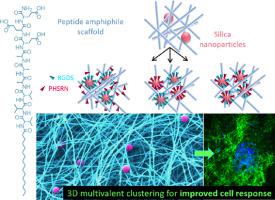Acta Biomaterialia ( IF 9.4 ) Pub Date : 2020-11-07 , DOI: 10.1016/j.actbio.2020.11.009 Dounia Dems , Ronit Freeman , Kyle D. Riker , Thibaud Coradin , Samuel I. Stupp , Carole Aimé

|
Because the positioning and clustering of biomolecules within the extracellular matrix dictates cell behaviors, the engineering of biomaterials incorporating bioactive epitopes with spatial organization tunable at the nanoscale is of primary importance. Here we used a highly modular composite approach combining peptide amphiphile (PA) nanofibers and silica nanoparticles, which are both easily functionalized with one or several bioactive signals. We show that the surface of silica nanoparticles allows the clustering of RGDS bioactive signals leading to improved adhesion and spreading of fibroblast cells on composite hydrogels at an epitope concentration much lower than in PA-only based matrices. Most importantly, by combining the two integrin-binding sequences RGDS and PHSRN on nanoparticle surfaces, we improved cell adhesion on the PA nanofiber/particle composite hydrogels, which is attributed to synergistic interactions known to be effective only for peptide intermolecular distance of ca. 5 nm. Such composites with soft and hard nanostructures offer a strategy for the design of advanced scaffolds to display multiple signals and control cell behavior.
中文翻译:

纳米纤维-纳米颗粒复合材料中粘附配体的多价簇化
由于生物分子在细胞外基质中的定位和聚集决定了细胞的行为,因此将生物活性表位与可在纳米级调节的空间组织结合在一起的生物材料的工程设计至关重要。在这里,我们使用了一种高度模块化的复合方法,将肽两亲性(PA)纳米纤维和二氧化硅纳米颗粒结合在一起,它们都可以通过一个或多个生物活性信号轻松地进行功能化。我们表明,二氧化硅纳米粒子的表面允许RGDS生物活性信号的聚集,从而导致复合水凝胶上成纤维细胞的粘附和扩散,其表位浓度远低于仅基于PA的基质。最重要的是,通过结合纳米颗粒表面上的两个整联蛋白结合序列RGDS和PHSRN,CA。5纳米 此类具有软纳米结构和硬纳米结构的复合材料为高级支架的设计提供了策略,以显示多种信号并控制细胞行为。











































 京公网安备 11010802027423号
京公网安备 11010802027423号